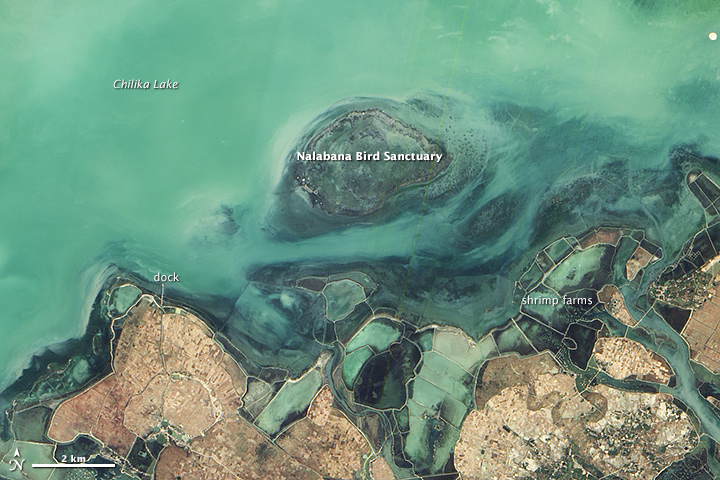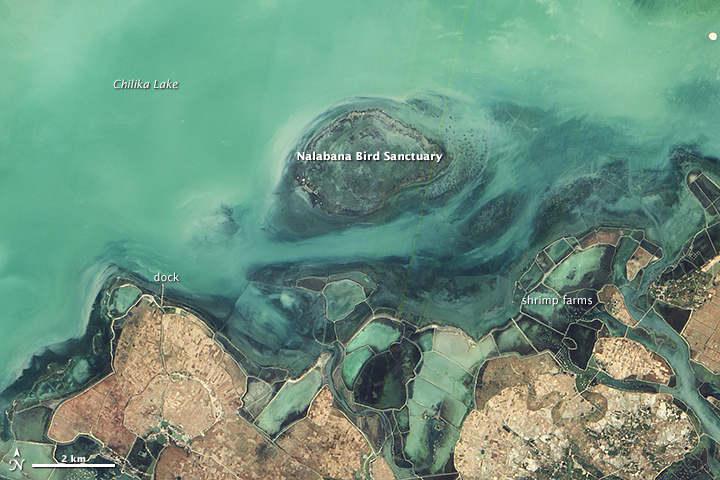Chilika Lake on the coast of Odisha is a huge tourist attraction, being the biggest brackish water lagoon in India and the second largest in the world. Tourists flock here by the thousands for the spectacle, but also for its varied wildlife. Yes, the lake is home to a number of endangered species, chief amongst them the migratory birds of the Nalbana Bird Sanctuary.
Situated near Barkul, the sanctuary is actually an island in the Chilika wetlands covering about 15.5 square km. The island’s name comes from the Odia language meaning weed covered island. During monsoon, the island submerges under the brackish water of the Chilika and reemerges during the winter months. It is during these winter months that birds from various parts of the world find shelter here.
No one is allowed to set foot on the island itself and the Government of Odisha enforces this rule diligently.
History
The Nalbana Bird Sanctuary was established in 1987, under the Wildlife Protection Act 1972. This was done as it forms the core of a wetland area designated as protected under the Ramsar Convention on Wetlands of International Importance. For a long time, the site was considered endangered due to changes in salinity of the lake water and growing encroachment by commercial shrimp farming as late as 2017. However steps taken by the Government of Odisha have had a positive effect on the island’s ecosystem and they are now on the road to recovery.
Species
This bird sanctuary is home to many species. Among them are greater flamingos from Iran and the Rann of Kutch in Gujrat which wade into the shallow waters around the island. Other waders like lesser flamingos, Goliath herons, grey herons, purple herons, egret, spoonbills, storks and the black headed ibis also stay here in the winter.
There are several rare species who roost here, like the Asiatic dowitcher, Dalmatian pelican, Pallas’ fish-eagles, the very rare spoon billed sandpiper and the spot billed pelican. You can find eagles and raptors in the population as well, like white bellied sea-eagle, pariah kite, brahminy kites,kestrel, marsh harriers and even the peregrine falcon.
You may find many short legged shorebirds in the narrow band between the lake and the island shore like plovers, the collared pratincole, ruff, dunlin, snipes and sandpipers. The mudflats are also homes to larks, wagtails and lapwings. The deeper waters feature avocets, stilts and godwits.
Closer to the shore, where there is greater vegetation, you may find moorhens, coots and jacenas. Pond herons and night herons are also a common sight alongwith kingfishers, rollers and little cormorants. There are also flocks of brahminy ducks alongside shovellers, pintails, gadwells, teals, pochards and geese.
Nesting colonies of gull-billed terns and river terns have also been observed. In fact, the Bombay Natural History Society recorded 540 nests of the Indian river tern, largest colony recorded so far in southeast Asia.
Human Impact and Steps Taken
Commercial fishing and shrimp farming have wreaked untold havoc on the ecology of the lake. The reduction of fish stocks in the lake have led to reduction in the number of birds roosting here and the rapid growth of shrimp farms near the islands have changed the acidity and salinity of the lake waters nearby, which threatens the mangroves of the island and also the food source for the birds, which are algae, small crustaceans, fish, shellfish and insects.

However, the Government of Odisha is now cracking down on illegal fishing and encroachment by shrimp farms. Many illegal shrimp farms were dismantled in 2019, giving the birds of Nalbana some breathing room.
No visitor is allowed on the sanctuary itself. Any tourist visiting the island would have to console themselves with looking at the island from a boat outside the boundary of the protected area.
You can read our another post on Forest Fire in Odisha: A Devastating Threat to Biodiversity and Ecosystems
How and When to Visit
The ideal time to visit the Nalbana Bird Sanctuary is October to March when the monsoon water recede from the lake. You cannot visit the island itself, as it is protected but boat rides around the Chilika Lake can stop along the boundary of the sanctuary so that you can take pictures.
The closest international airport is Bhubaneshwar, from where you can take the road to Balugaon, a two hour journey and the an hour’s boat ride to the sanctuary itself. Accommodations are available at Balugaon and Barkul and Balugaon is connected by rail via the Howrah-Chennai line.
For taking pictures we recommend high power telephoto lenses and cameras with vibration compensation. A tripod will not go amiss. We also recommend lens hoods as the lighting is usually not ideal for photography. A good pair of binoculars are also essential for spotting rare birds.
Conclusion
The Nalbana Bird Sanctuary is the ideal destination for the environmentally minded tourist, who wants to see rare bird species living in the wild. The efforts of conservationists and the common people have kept this ecologically active area alive and this has helped many rare species Nalbana Bird Sanctuary .
This winter holiday, when you make plans for a vacation, keep this paradise for birdkind in mind Nalbana Bird Sanctuary .
Sources
- Nalbana Bird Sanctuary, Wikipedia https://en.wikipedia.org/wiki/Nalbana_Bird_Sanctuary
- NASA Earth Observatory https://earthobservatory.nasa.gov/images/83431/chilika-lake-and-nalabana-bird-sanctuary
- The Birds of Odisha’s Nalbana, Nivedita Ganguly, The Hindu https://www.thehindu.com/life-and-style/travel/the-birds-of-nalabana/article26192823.ece
More: Wanted to download Odishashop.com visit here

